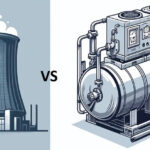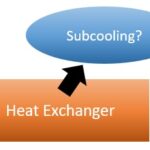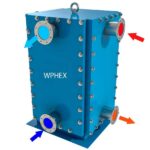Shell and tube heat exchanger performance is affected by several factors. This short article will discuss briefly these factors.
Shell and tube heat exchanger performance
The main problems affecting the shell and tube heat exchanger performance are usually due to one of the following:
+ Fouling
+ Tube vibrations
+ Leakage
+ Dead Zones
Fouling
This can be generally defined as the precipitation of unwanted material within the heat exchanger over time which hamper the performance.
The principal types of fouling encountered in process heat exchangers include:
• Particulate fouling
• Corrosion fouling
• Biological fouling
• Crystallisation fouling
• Chemical reaction fouling
• Freezing fouling
In the case of corrosion, the surfaces of the heat exchanger can become corroded as a result of the interaction between the process fluids and the materials used in the construction of the heat exchanger.
The situation is made even worse due to the fact that various fouling types can interact with each other to cause even more fouling. Fouling can and does result in additional resistance with respect to the heat transfer and thus decreased performance with respect to heat transfer.
Fouling also causes an increased pressure drop in connection with the fluid flowing on the inside of the exchanger.
To improve the performance of fouled heat exchangers requires that the tubes be cleaned periodically. Tube cleaning procedures for shell and tube heat exchangers are performed off-line, the most frequently chosen and fastest method being mechanical cleaning.
Among other off-line methods is the use of very high pressure water but, since the jet can only be moved along the tube slowly, the time taken to clean a heat exchanger can become extended. Chemicals are also used for the off-line cleaning of heat exchanger tubes.
Several mildly acidic products are available and will remove more deposit than most other methods; but it is expensive, takes longer for the operation to be completed, and the subsequent disposal of the chemicals, an environmental hazard, creates its own set of problems.
Tube vibrations
Another problem affects shell and tube heat exchanger performance that often arises in connection with the use of heat exchangers is tube vibration damage. Tube vibration is most intense and damage is most likely to occur in cross flow implementations where fluids flow is perpendicular to the tubes, although tube vibration damage can also occur in non cross flow (i.e. axial) implementations in the case of very high fluid velocities.
Vibration may be eliminated by reducing velocities, decreasing the unsupported span or, in some cases, by altering the method of fixing or pinning the ends of the unsupported span.
This problem can cause significant damage to the exchanger if within high limits.
Leakage
Sometimes the fluid of the tube side can leak to shell side or vice versa, This problem can cause huge production loss and ultimately affect shell and tube heat exchanger performance.
Leaks may develop at the tube to tube sheet joints of fixed tube sheet exchangers because differential thermal expansion between the tubes and the shell causes overstressing of the rolled joints. Or, thermal cycling caused by frequent shutdowns or batch operation of the process may cause the tubes to loosen in the tube holes. Floating heads or U-bend exchangers would be considered first for this type of service.
If a fixed tube sheet unit is required, an expansion joint will be specified. An exchanger that will be thermally cycled two or three times a day will require superior mechanical construction such as the strength welding of tubes to the tube sheet, complete inspection of the shell and channel welds during fabrication.
Welding the tubes to the tube sheets does not guarantee that a leak will not occur as sometimes weld failure due to porosity in the welds or just one poorly welded tube out of the hundreds of welds can cause a leakage.
The use of double tube sheets to minimise the chances of leakage between the tube side and shell side can be a good solution to the problem. Nevertheless, double tube sheet can cause considerable maintenance problems because the outboard and inboard tube sheets may be subjected to considerably different process temperatures and this can have differential expansion between the tube sheets resulting in bending the tubes.

Dead zones
Areas that have the flow to minimal or even non existent and usually produce poor heat transfer and can lead ultimately to excessive fouling. This ultimately impact shell and tube heat exchanger performance.
Existing shell and tube heat exchangers suffer from the fact that they must typically use baffles to maintain the required heat transfer. This, however, results in “dead zones” within the heat exchanger where flow is minimal or even non existent. These dead zones generally lead to excessive fouling. Other types of heat exchangers may or may not employ baffles.
If they do, the same increased fouling problem exists. Further, in heat exchangers fitted with baffles, for example, the cross flow implementation results in the additional problem of potential damage to tubes as a result of flow induced vibration. In the case of such damage, processes must often be interrupted or shut down in order to perform costly and time consuming repairs to the device.
Hopefully this article provided some insights on problems affecting shell and tube heat exchanger performance.
Keywords
shell and tube heat exchanger performance, Shell and tube heat exchanger design











